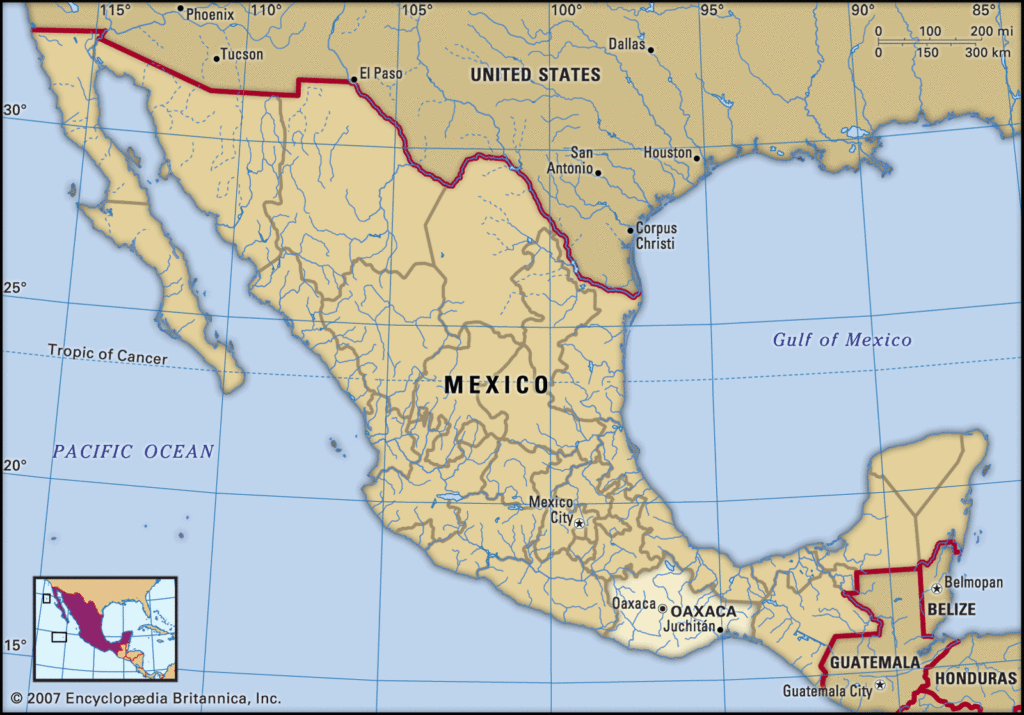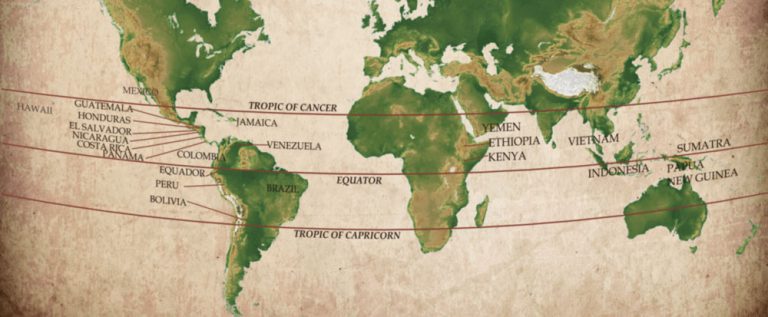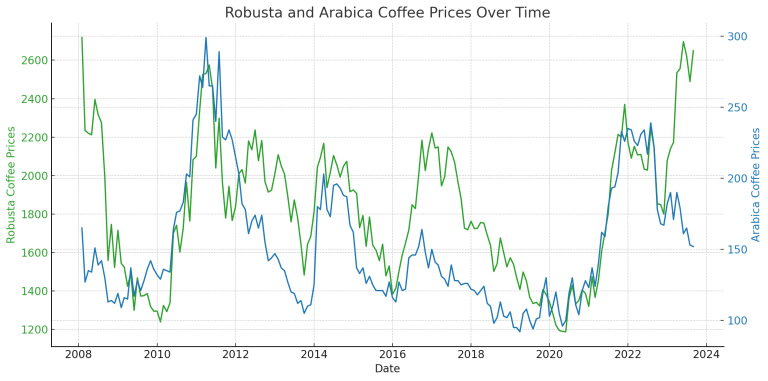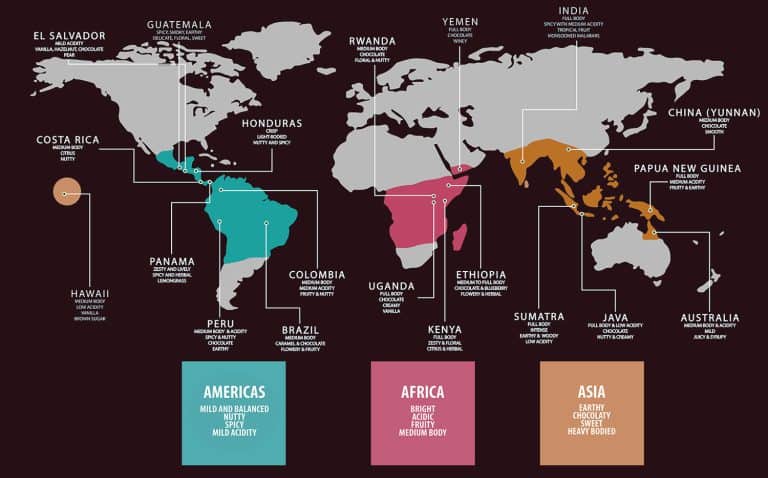Mexican Coffee: A Taste of Culture, Heritage, and Climate
Mexican Coffee is important for American consumers for a variety of reasons: Half a million farmers are currently producing delicious coffee, it’s a relatively close growing region, 60% of organic coffee comes from Mexico, and trade programs help control price volatility to protect vulnerable farmers and their communities.
When I first visited Mexico I was intrigued by fresh flavor combinations I hadn’t experienced anywhere else. My very first Mexican coffee was in a cafe in Coyoacán after visiting the house and museum of Frida Kahlo. Imagine Spanish Colonial architecture, swaths of color, tropical vegetation, and a bustling economy!
Whether you’re looking for an authentic recipe or the best quality Mexican coffee beans, we hope you’ll find this article useful.
The Mexican Coffee Culture
Traditionally, coffee from Mexico is served with tequila and liqueur. It is treated as an essential part of lunch or dinner’s sobremesa, where people usually socialize and relax after eating a good meal.
Mexico’s coffee culture is kind of laid back despite the presence of Starbucks, Italian-inspired espresso drinks, and Americanos. Perhaps a vestige from the Spanish colonization, it’s not uncommon to see locals sipping cortados while lingering and chatting with their amigos around 4 PM.
Mexican Coffee Drinking by Age
Everyone drinks coffee in Mexico. Adults indulge in their coffee mixed with liqueur, younger generations enjoy drinking Mexican coffee beans brewed with cinnamon and sugar. These sweet spices are added right into any brewing technique and coffee maker. Whether it’s French Press or pour-over, as long as the coffee tastes great, Mexicans will drink it.
Although most excellent-tasting coffee comes from the center and southern regions of Mexico, Mexicans take their coffee differently. Mexicans in the North love their coffee with lots of milk and sugar. They drink coffee in the American style since people were heavily influenced by how Americans drink their coffee.
Although coffee has been around in Mexico since the 1700s, it is just recently that Mexicans are embracing gourmet coffee. Ordinary people still drink tea, but indigenous and traditional communities have favored chocolate drinks with cinnamon sticks over coffee. In short, the climate, the locally produced crops, and the mix of cultures are what make the beverages distinctive.
Popular Mexican Coffee Drinks & How to Make Them
Your stay in Mexico would not be complete without trying authentic Mexican coffee drinks. However, if you find Mexican coffee intriguing and just want to sample a regional beverage, we’ve gathered some of the best Mexican coffee drink recipes you can try at home. These are:
Cafe de Olla Recipe
Café de olla is a traditional coffee drink brewed in clay pots with cinnamon and piloncillo. If you want to add more kick and aroma to this delicious brew, you can add anise, clove, or orange peel. To prepare this coffee, Mexicans use earthen clay pots because it enhances the overall coffee flavor. For a simple home brewing process of Mexico coffee, you can follow the recipe below:
Ingredients:
- 8 cups of water
- 3 ounces of dark medium-coarse grind coffee
- 5 ounces of piloncillo or 1 cup of brown sugar
- One cinnamon stick
Optional ingredients to add for an aromatic Cafe de Olla is one orange peel as it gives a sweet, citrusy complexity after taste and aroma. Piloncillo is an unrefined sugar sold in cones. It’s a rare ingredient in the US supermarkets but is a common spice in the Mexican markets. Authentic cafe de olla uses piloncillo, but you can use a brown sugar cup as an alternative if you can’t find one.
Instructions:
- In a medium saucepan, pour your 8 cups of water and bring to boil.
- Dissolve the piloncillo or brown sugar in the boiling water.
- Afterward, add the coffee grounds, the cinnamon stick, and the orange peel (optional).
- Cover the saucepan and turn off the heat. Steep the mixture for 10 minutes.
- Use a fine mesh or a cheesecloth to strain the cinnamon sticks and other added spices while transferring the coffee liquid in a carafe. You can also use the French Press by removing the cinnamon sticks with a spoon. Afterward, press the plunger to separate the grounds from the extracted liquid.
- Pour the coffee in your favorite mug and garnish it with cinnamon sticks or orange peel to make it Instagrammable.
Carajillo Recipe
Carajillo is easy to prepare a Mexican coffee cocktail mixed with Licor 43 over ice to create a beautiful layered effect. It is often served as an after-dinner beverage or as a dessert course. It’s a perfect drink for a relaxing, warm evening.
Ingredients:
- ½ cup of brewed espresso or decaf espresso of choice
- 2 ounces of Licor43
- Eight ice cubes
Instructions:
- Pour the Licor43 over the ice cubes first in a glass.
- For a layered effect, pour the espresso gently over at the back of the spoon.
- Serve with a cocktail stirrer.
Cortado Recipe
Cortado is centered in the spectrum of a macchiato and a cappuccino. It’s a combination of one-shot espresso and equal parts of steamed milk. Some cafes serve doppio while others serve with more milk. You can drink this tasty coffee in small cups made of metal or glass.
Ingredients:
- Two shots of espresso
- 2 ounces of steamed milk (we recommend almond or oat milk)
Instructions:
- Using your espresso machine or a French Press, brew two shots of espresso.
- Steam the milk between 120 and 130 degrees Fahrenheit.
- Slowly pour the steamed milk over your espresso. Make sure that the ratio of the two ingredients is 1:1.
Mexican Coffee: History and Politics
Coffee cultivation in Mexico began in the late 18th century as Mexico was colonized by Spain. However, serious coffee cultivation/production didn’t really take off until after the Mexican Revolution (1910-1920)
Trade Councils and Cooperatives play a major role in helping farmers bring their harvested green beans to market. There’s a lot of great information on the Equal Exchange website.
The video below shows in great detail how Mexican coffee beans are grown, harvested, processed, sold, roasted, and then brewed in a cafe. This is a great example of how the supply chain works between Mexico and a farm-to-table restaurant in the UK.
Mexican Coffee Growing Regions: What Coffees Does Mexico Produce?
Now let’s take a look at the coffee-growing regions in Mexico:
Chiapas

- Chiapas, Mexico
- Elevation: 1200-1800m
- Coffee Aroma and Taste: Clean, balanced, light-nut and fruit flavors; Chocolatey with medium body and crisp acidity.
- Other things: Close proximity to Guatemala; shares climate characteristics. The largest producer of all regions where the vast majority of farms are family-owned with less than 10 acres of land. The coffee harvest typically begins in October and ends in March. In 2014 a severe case of “coffee leaf rust” or “La Joya” decimated much of the production from this southern region of Mexico.
Oaxaca

- Elevation: 900 to 1,650m (3000 -5400 ft)
- Taste Profile: Complex flavors with floral notes; Oaxaca coffee is sweet-toned with caramel overtones. The beans also have hints of yellow fruits, orange tanginess, and a creamy body.
- Other things: Most farmers practice traditional coffee cultivation methods with 80-year-old farms managed in the 1940s farming style. Pluma Hidalgo is one of the coffee beans that is cultivated on farms in Oaxaca. Most coffee plants came from the displaced offshoot Typica varietals.
Veracruz

- Veracruz, Mexico
- Elevation: 1200-1800m
- Taste Profile: Known for earthy, chocolate flavors
- Other things: Notable for Huatusco and Coatepec Regions. Veracruz is considered the first region in Mexico to produce coffee and Coatepec is considered the ” capital of coffee.” Visiting Veracruz, you can easily find fincas to tour and taste the diverse varieties and flavors of Mexican coffee.
Cultivation Methods: Shade Grown and Wet Process
While Mexican coffee is a very big part of the agricultural output of Mexico and elsewhere, coffee farms are not treeless, arid swaths of land tilled with a tractor. This isn’t corn. Coffee beans grow among mountains, along hillsides and to the untrained eye may look like some random plant in a jungle.
Wet Process: According to Coffee Research Institute the wet process is a relatively new ( though primitive) method for removing the inner pit (coffee bean) from the harvested coffee fruit. The process involves rinsing and crushing the coffee fruits until the inner pit can be separated from the fruit. This “pit’ is the coffee bean that is eventually roasted and consumed. This imparts a cleaner, brighter, and fruitier flavor upon the finished product – a “green”, unroasted coffee bean. In regions where coffee tends to be more ” acidic” this method is more common. More traditional methods include the Dry-Process (sunny, arid regions) or the Pulping-Method.
Shade Grown: Unlike sun-grown, large-scale commercial enterprises ( coffee farms), Shade-Grown Mexican coffee is a more primitive, natural, eco-friendly method of growing coffee. Using the dense jungle canopy to protect the coffee plants, the natural setting provides a habitat for wildlife, and requires fewer pesticides, fertilizers, and/or commercial agricultural infrastructure. The less manicured farms let the naturally conditioned soils impart more complex flavors on their plants and protect the local areas from erosion, water shortages, and other problems associated with Big Ag.
Organic and Fair-Trade Mexican Coffee
Mexico currently ranks 8th in annual coffee production worldwide. Trade Deals with large-scale buyers like Starbucks comprise most of Mexican coffee bean sales however smaller, organic growers comprise 60% of the World’s supply of Organic Fair Trade Coffee.
“Fairtrade was set up to ensure coffee farmers receive a fair and stable price for their coffee that covers average costs of sustainable production.”
“ The model and success of Mexican co-operatives and civic organization has laid the groundwork for some of the most compelling social movements in the world.”
https://www.fairtrade.org.uk/en/farmers-and-workers/coffee/about-coffee
If you’re curious about the differences between Fair Trade and the others, check out our article about Fair Trade coffees.
Mexican Altura
Altura is not a coffee blend offered in most Mexican coffee brands. If your Mexican coffee is labeled as “Altura,” it means that it is the finest grade of Mexican coffee beans. Coffee beans labeled “Altura” are those cultivated in coffee farms at high altitudes.
When it comes to coffee beans grading, green coffee beans are graded by two quality standards in Mexico. These are Normas Oficiales Mexicanas (NOMs) and Normas Mexicanas (NMX). The grading is based on the specifications set to meet the standards.
Mexican History and Politics Related to Agriculture and Coffee Production
1962 was a bright economy for Mexico with coffee as its prime export product. The establishment of the International Coffee Agreement in the same year has brought stability to coffee-growing countries. This agreement aims to maintain high coffee prices that will support the country’s national revenue.
Yet in 1989, the International Coffee Organization failed to reach an agreement that pertains to export quotas. It led to the disintegration of the 1962 coffee agreement. Dark times arrived in Mexico when it entered the 90s with the overproduction of coffee in the market worldwide, and none of the exporting countries wanted to stop the production.
Third-generation coffee growers blame this bloody competition for prevailing poverty as coffee pickers’ wages were not increased for three years. Some coffee growers started to pull out their coffee bushes and replaced them with sugar cane. Other growers in remote areas are supporting their revenue by planting opium poppies or marijuana.
Another reason for the disintegration of the 1989 INMECAFE is the Mexican government’s declared policy that it would give up its share in the coffee market as a response to the construction adjustments of the World Bank and other financial institutions. Such a policy left small coffee producers unprotected; thus, poor maintenance of coffee plantations ensues.
Mexico managed to gain momentum by the 2000s with coffee producers’ reorganization into cooperatives and taking advantage of the burgeoning markets. Coffee cooperatives were certified for direct trade, fairly traded, and organic coffee, which became beneficial to coffee producers in the most remote and vulnerable regions.
In recent years, the rise of many Mexican coffee-growing cooperatives has put a lot of pressure on the government to invest more in coffee production. The constant increase in the high price of coffee globally helped the coffee producers persuade the government to invest once more into coffee since it became an attractive business more than during the 1990s coffee crisis.
In 2012, the first competition of Cup of Excellence was held in Mexico, and it opened doors to the improvement of specialty markets and awareness to Mexican coffee’s potential buyers. The establishment of the Mexican Association of the Productive Coffee Chain (AMECAFE) also showed promising feats to revitalize the Mexican coffee production through its specialty coffees, now being exported to the UK, Canada, Japan, and the United States.
Facts About Mexican Coffee
Current Trends in Production
- Coffee rust problems significantly affect coffee production in Mexico, but with the government’s 2016 policies (see PIAC in Spanish), the coffee production increased.
- From the total coffee production of Mexico, 96% of it is Arabica coffee beans, while 3% to 4% is Robusta.
- Mexico plans to increase its production of Robusta coffee to take advantage of the growing demands and consumption.
- 7% to 8% of organic Mexican coffee is produced for export purposes.
- Newly planted areas have switched to pest-resistant coffee varieties, including Marsellesa, Sarchimor, Oro Azteca, Costa Rica 95, and other pest-resistant types from Guatemala and Nicaragua.
Certification and Partnerships
- Gourmet or premium coffee producers in Mexico are certified by third-party and independent agencies such as Fair Trade (e.g., FLO labels) and USDA Organic certified (e.g., Naturland labels).
- Sustainable coffee producers in Mexico are certified by BirdFriendly, Rainforest Alliance, and Utz.
These certifications provide higher coffee prices per pound of coffee and higher gross coffee revenue for certified coffee producers than non-certified coffee producers in Mexico.
Summary
Contrary to search results and some common experiences in small, rural cafes throughout Mexico, not every cup of coffee is made from instant coffee or flavored coffee with cinnamon and spices. Coffees grown in Mexico are truly wonderful if you’re willing to do a little research and try the freshest available coffee.
We hope you like our page and if you feel we’ve missed something, please reach out to us. We’d be happy to update this page with relevant information.








I must say, the Cortado recipe in this article is a real game-changer. I’ve been trying to replicate the coffee I enjoyed in Mexico City, and this is the first time I got it right. Whoever hasn’t tried it yet, you’re missing out.
Tom really nailed it with the history section. As someone who’s studied the impact of agriculture on Mexican politics, it’s refreshing to see this topic discussed in relation to coffee production. It’s often overlooked but so integral to understanding the industry’s nuances.
Just wanted to ask for clarification on the political history section—it’s mentioned briefly but sounds crucial. How exactly did politics play a role in Mexican coffee production? I’m curious about the socio-economic aspects.
I’m a bit confused about the cultivation methods mentioned. Shade-grown and wet process are new terms for me—could someone elaborate on how these impact the flavor profile of Mexican coffee?
Please do a search on the site, I have written articles on these topics.
After reading through this fascinating article, I felt compelled to share my own experience. I visited Oaxaca last year, and your description of Mexican coffee culture is spot on. Sipping on a cup of locally-grown coffee amidst the bustling markets was a highlight of my trip.
I’ve always been intrigued by Mexican coffee but never knew where to start. Thanks to Tom’s deep dive into the culture and recipes, I brewed my first ever Cafe de Olla at home. The aroma was like a warm embrace, and that subtle hint of cinnamon really transported me. Muchas gracias for such an enlightening article.
Who else is gearing up to try making Carajillo this weekend? The article really piqued my interest, especially the suggestion of using a quality tequila or liqueur to blend with the coffee. Sounds like the perfect drink to enjoy as the weather warms up.
Interesting article. I’ve been roasting my own beans for a while now, and Mexican Altura is a personal favorite. It’s got a unique profile, with some spectacular nutty and chocolate notes. Tom did a great job highlighting why these beans are special.
Mexican coffee being an integral part of the sobremesa tradition really resonates with me. After living in Mexico for a while, those long, leisure conversations over a cup of coffee became a regular part of my social life. It’s about community just as much as it is about the caffeine.
As an avid bird watcher and ecological activist, it’s fantastic to see Mexican shade-grown coffee highlighted. These cultivation methods preserve biodiversity and provide bird habitats, which is essential for sustainability. Kudos to the author for bringing attention to this.